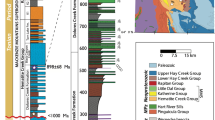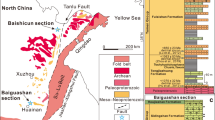Abstract
In 1997 and 1998, hundreds of specimens of megascopic carbonaceous compressions or algal fossils were found from ∼ 1800-million-year old Changzhougou Formation, which is the lowermost unit of the latest Palaeoproterozoic Changcheng Group (∼1 600–1 800 Ma) in the Xinglong-Kuancheng areas at the middle Yanshan Range, North China. They are discoid, ellipsoid and sausage-like, namely shaped likeChuaria Shouhsiennia (Ellipsophyta) andTawuia. By adopting HF acid-resistant maceration coupled with scanning electron microscope and petrologic section, the authors made a preliminary research on the histology for some circular and ellipsoid carbonaceous compressions, namelyChuaria- andShouhsienia-like forms, in addition to their morphology. The following three types of multicellular tissues have been found in the fragments of them: colony-like, pseudoparenchyma-like and parenchyma-like. All of the new data about multicelluar tissues not only supply a very important basis in histology to determine the biological affinity of multicellular algal remains for the Changzhougou carbonaceous compressions newly found, but also provide reliable fossil evidence to prove that metaphytes originated at least 1 800 million years ago.
Similar content being viewed by others
References
Bengtson, S., Fedonkin, M., Lipps, J. H., The major biotas of Proterozoic to Early Cambrian multicellular organisms, in The Proterozoic Biosphere (eds. Schopf, J. W., Klein, C.), Cambridge: Cambridge University Press, 1992, 433–435.
Sun, W. G., Early multicellular fossils, in Early Life on Earth (ed. Bengtson, S.), New York: Columbia University Press, 1994, 358–369.
Hofmann, H. J., Precambrian biostratigraphy, Paleoscene #7, Geoscience Canada, 1987, 12(3): 35.
Hofmann, H. J., Proterozoic carbonaceous compressions (“metaphytes and worms”), in Early Life on Earth (ed. Bengtson, S.), New York: Columbia University Press, 1994, 342–375.
Zhang, Y., Multicellular thallophytes with differentiated tissues from Late Proterozoic phosphate rocks of South China, Lethaia, 1989, 22: 113.
Butterfield, N. J., Knoll, A. H., Swett, K., A bangiophyte red alga from the Proterozoic of Arctic Canada, Science, 1990, 250: 104.
Zhu, S., Chen, H., Megascopic multicellular organisms from the 1700-million-old Tuanshanzi Formation in the Jixian area, North China, Science, 1995, 270: 620.
Yan, Y., Liu, Z., Tuanshanzian macroscopic algae of 1700 Ma B.P. from Changcheng System of Jixian, China, Acta Palaeontologica Sinica (in Chinese), 1997, 36(1): 18.
Xu, Z., Cui, B., Sinian Suberathem in the Eastern Yanshan ranges, in Research on Precambrian Geology—Sinian Suberathem in China (in Chinese) (ed. Tianjin Institute of Geology and Mineral Resources, Chinese Academy of Geological Science), Tianjin: Tianjin Science and Technology Press, 1980, 358–369.
Zhang, H., Zhang, W., Elston, D. P., Palaeomagnetic study on Middle and Late Proterozoic Rocks in Jixian, North China. Acta Geophysica Sinica (in Chinese), 1991, 34 (5): 602.
Yu, R., Zhang, X., Study of geochronology of Late Precambrian in the Yanshan ranges, Bulletin of the Tianjin Institute of Geology and Mineral Resources, CAGS, 1984, 11: 1.
Xing, Y., Duan, C., Liang, Y. et al. (eds.), Late Precambrian Paleontology of China (in Chinese), Beijing: Geological Publishing House, 1985, 68–77.
Zheng, W., A new occurrence of fossil group ofChuaria from the Sinian System in North Anhui and its geological meaning, Bulletin of the Chinese Academy of Geological Sciences (in Chinese), 1980, 1(1): 49.
Hofmann, H. J., Aitken, J. D., Precambrian biota from the Little Dal Group, Mackenzie Mountains, northwestern Canada, Canadian Journal of Earth Sciences, 1979, 16 (1): 150.
Bold, H. C., Wynne, M. J., Introduction to the Algae, Englewood Cliffs, New Jersey: Prentice-Hall, Inc, 1978, 267–343.
Zhang, Y., Histological study on the Newproterozoic organism’s fossil remains: implication for origin of multicellularity and sexuality, Proc. 30th Intern. Geol. Congr., 1997, 1: 187–199.
Hofmann, H. J., Chen, J., Carbonaceous megafossils from the Precambrian (1 800 Ma) near Jixian, Northern China, Canadian Journal of Earth Sciences, 1981, 18(3): 443.
Zhu, S., Xing, Y., Zhang, P. et al. (eds.), Biostratigraphic sequence of the Middle-Upper Proterosoic on North China Platform (in Chinese), Beijing: Geological Publishing House, 1994, 117–129.
Xiao, S., Zhang, Y., Knoll, H., Three-dimensional preservation of algae and animal embryos in a Neoproterozoic phosphorite, Nature, 1998, 391: 553.
Zhu, S., Wang, Y., Posphatic stromatolites and mocrofossils from the Doushantuo age in the central Guizhou, in The upper Precambrian and Sinian-Cambrian boundary in Guizhou (in Chinese) (ed. Wang, Y.), Guiyang: The People’s Publishing House of Guizhou, 1984, 93–106.
Author information
Authors and Affiliations
Corresponding author
About this article
Cite this article
Zhu, S., Sun, S., Huang, X. et al. Discovery of carbonaceous compressions and their multicellular tissues from the Changzhougou formation (1800 Ma) in the Yanshan range, North China. Chin.Sci.Bull. 45, 841–847 (2000). https://doi.org/10.1007/BF02887415
Received:
Issue Date:
DOI: https://doi.org/10.1007/BF02887415




